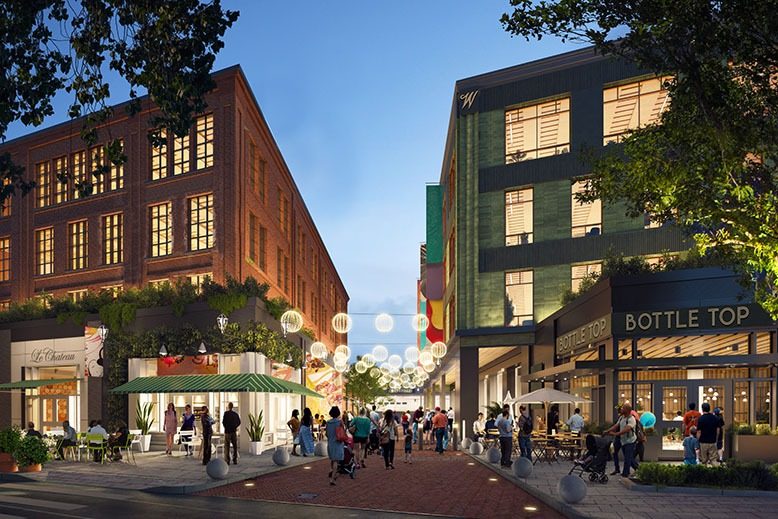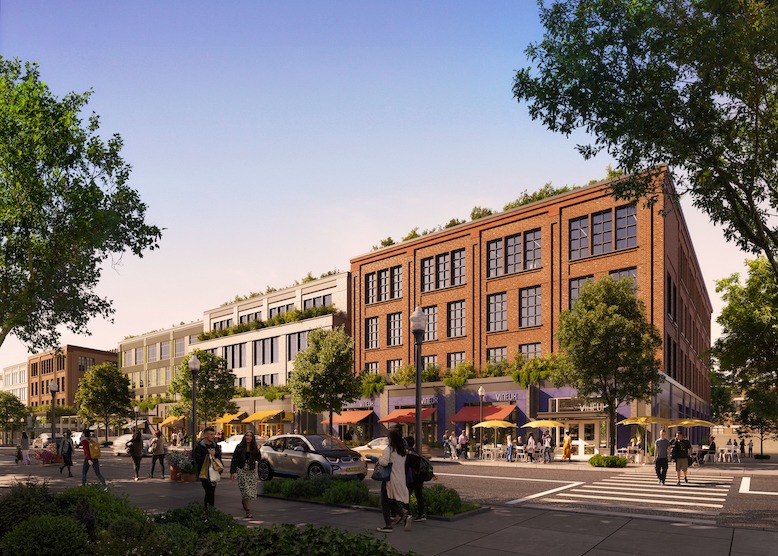
The Lord & Taylor department store was a mainstay in Westfield for nearly 60 years, a venerable anchor on the edge of the Union County suburb’s vibrant downtown.
But the store turned off the cash registers and shut its doors in 2020. That left a void—but also an opportunity to reengineer a walkable and bikeable “downtown of the future,” says Mayor Shelley Brindle, who is backing a plan to use more than $400 million in private investment for mixed-use redevelopment, totaling 14 acres, at the Lord & Taylor site and nearby town-owned parking lots.
Like the Westfield Lord & Taylor, many stand-alone downtown department stores have become relics, swept aside by suburban malls and, more recently, online shopping. A number of cities and towns around the state—including Asbury Park, Morristown, Newark, Hackensack and Millburn—have acted to remake the sites that were once the heart of their downtowns.
The projects take advantage of a wider trend in the Garden State: a surge of downtown multifamily and mixed-use development reflecting residents’ growing interest in living in dense, pedestrian-friendly environments—the same vibe that attracted the department stores so many decades ago.
“People want to live in compact, walkable places. They want to be able to drive less, and that’s historically how our cities and towns and downtowns were developed, before the car was king,” says Peter Kasabach, executive director of NJ Future, a Trenton-based nonprofit that advocates for smart growth and redevelopment. The best downtown redevelopments, he adds, offer pedestrians a variety of experiences: window shopping, people watching, getting coffee, eating in a restaurant.
[RELATED: 12 Small Towns to Visit Now]
Developers and municipalities see opportunity in the old department store properties, which often include large parking lots and can offer a relatively expansive canvas for their ambitions.
Short Hills-based Garden Communities is building a $110 million, 270-unit apartment and townhouse rental community called the Metropolitan on the site of a former Saks Fifth Avenue in Springfield, adjoining Millburn.
“For a 10-acre parcel to be available on Millburn Avenue on the border of Springfield and Millburn is really something that was hard to come by,” says Scott Loventhal, managing director of Garden Communities.
Another nearby department store, a former Lord & Taylor in Millburn, has already been converted into a mixed-use building that holds medical offices, a Trader Joe’s and a CVS.

The One Westfield Place proposal includes retail space, 300,000 square feet of office space, more than 200 apartments and townhouses, parking garages, green space, and pathways adjacent to the train station. Rendering courtesy of Streetworks Development
Saks left its Springfield site in 1994, moving to the Mall at Short Hills (That location then closed in 2016). The Springfield property sat empty for decades, as local opposition and fears about traffic stymied a proposal to build a supermarket. According to Loventhal, the Metropolitan is expected to generate revenues for Springfield of about $1.1 million a year, projected to rise to $2.2 million in later years, through a 30-year payment in lieu of taxes (PILOT) agreement. Before the redevelopment, the site generated annual property taxes of about $200,000, Loventhal says.
PILOTs are based on a percentage of a project’s yearly revenues and typically generate less than the actual tax rate. They’re frequently used to encourage redevelopment; in some places, municipal officials say, the deals wouldn’t happen without the tax breaks. But some critics, including those opposing the Westfield plan, complain about the use of PILOTs in well-heeled suburbs, which they say can attract development without them.
SHUTTERED SPACES
Many of the departed department stores have colorful histories and memorable stories that still resonate. At Steinbach’s in Asbury Park, holiday shoppers got a shock in 1949, when a mechanical Santa toppled over and burst into flames. The Seeing Eye of Morristown used Epstein’s department store in the heart of town to train guide dogs to navigate interior spaces, because “it offered elevators, escalators and a variety of floor surfaces,” says Michelle Barlak, a spokeswoman for the Seeing Eye. And the facade of the Century 21 in Morristown features medallions honoring George Washington and other notables of New Jersey’s Revolutionary history.
Between Epstein’s and Century 21, Morristown has more experience than most communities with obsolete department stores. The family-owned Epstein’s closed in 2004, after 90 years in business. By 2010, the site was redeveloped into 40 Park, consisting of condos and ground-floor retail and restaurants. Morristown Mayor Tim Dougherty says the redevelopment, along with other projects, has helped enliven the downtown, where folks relax on the Green, stroll the sidewalks, and eat and drink at the many restaurants.
It’s also a financial help. According to the mayor, Epstein’s used to pay about $300,000 a year in taxes; in contrast, 40 Park brings in annual tax revenues of about $2.8 million.
“We’re in it to get more ratables and bring people into our downtown,” says Dougherty. “If you walk this town, you can see the result of what’s going on—people are walking around and spending money in our businesses. People want to live in downtowns. Small urban centers like Morristown are very attractive.”
[RELATED: Downtowns Are Breathing New Life Into Empty Old Banks]
But diagonally across the Green from 40 Park, the red-brick Century 21 department store has been vacant since the discount retailer declared bankruptcy in late 2020, the victim of a Covid sales slump. The building dates to 1949, when it opened as a Bamberger’s; it was later rebranded as Macy’s, but closed in 1993 and sat empty until Century 21 took the space in 2002. A recent peek through the storefront windows showed empty counters and shelves, and clothing racks huddled in forlorn groups.
What comes next for the building is not clear. The owner, Penobscot Management, which also owns most of the nearby properties along that side of the Green, has not announced plans and did not respond to requests for comment.
A DESTINATION DOWNTOWN
In Hackensack, plans are taking shape for the redevelopment of the landmark Sears built in 1932, as the city was becoming “a destination downtown,” says Albert Dib, director of redevelopment and economic development for the city. The Sears closed in 2020. The city expects the site to be redeveloped as a mixed-use project, part of a larger effort to revive Hackensack’s old shopping district and other neighborhoods, with an estimated 4,000 apartments planned or built in recent years.
In many of these redevelopment projects, developers find it’s not practical to keep the old buildings. But Hackensack officials want the Sears redevelopment to preserve the original Art Deco architecture.
In Asbury Park, the iconic V-shaped building that housed the flagship Steinbach department store was renovated with restaurants and retail on the ground floor and 63 loft-style apartments on the three floors above. The building, which dates to 1897 and became an eyesore after the department store closed in 1979, is considered a linchpin in the rebirth of Cookman Avenue. At around the same time, the Steinbach in Red Bank was remade into a home for the high-end clothier Garmany, reflecting the rising fortunes of that downtown.
The redevelopment of Hahne’s in Newark preserved the 1901-vintage store, including its airy, open atrium. The 400,000-square-foot store was vacant from 1987 to 2017, when it reopened as a Whole Foods Market, 160 apartments, a Barnes & Noble book store serving the Rutgers-Newark campus, and Express Newark, a Rutgers-created center for socially conscious art and design.
Another Hahne’s store, in the heart of downtown Montclair, has been replaced by apartments.
AN AMBITIOUS PLAN
The Westfield redevelopment plan, dubbed One Westfield Place, is one of the most ambitious department store rehabs. It includes retail space, 300,000 square feet of office space, more than 200 apartments and townhouses, parking garages, green space, and pathways adjacent to the downtown train station.
Backers say it will draw more foot traffic to the central business district, but opponents say it’s too big and fear it will compete with existing businesses. A suit has been filed to block the plan, and there are more than 2,400 signatures on a petition urging town leaders to rethink the development.
But town review and approvals are proceeding, and Mayor Brindle says the first stages of the redevelopment could begin in late 2024. The Westfield plan is spearheaded by Streetworks Development, the redevelopment arm of the Canada-based Hudson’s Bay Company, owners of Saks and Lord & Taylor.
Like other projects around the state, the Westfield plan is a public-private partnership that uses PILOTs.
Brindle notes that the Westfield plan includes more than $54 million in long-term public improvements funded by the PILOT, such as upgraded intersections and new green space.
“Our community is going to be in good hands for the future,” she says.
Kathleen Lynn and Patricia Alex are contributing writers to New Jersey Monthly. Both are former reporters and editors at The Record of Bergen County.
No one knows New Jersey like we do. Sign up for one of our free newsletters here. Want a print magazine mailed to you? Purchase an issue from our online store.



